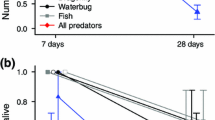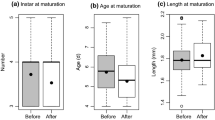Abstract
Predators shape the phenotype of prey by means of local adaptation, within-generation plasticity, and transgenerational plasticity. Theory predicts that the influence of these three mechanisms on phenotype is determined by the number of generations exposed to the predator and the autocorrelation between parent and offspring predator environments. To test theoretical predictions about the relative effects of local adaptation, within-generation plasticity, and transgenerational plasticity on prey phenotype, we exposed two generations of freshwater snails (Physa acuta) from two populations—one from a large pond containing predatory fish and one from a set of small ponds that lacked predatory fish—to the cues from a predaceous bluegill sunfish (Lepomis macrochirus). Physa acuta exhibit both local adaptation and phenotypic plasticity in response to predation risk; thus, we predicted that snails from the population with fish and snails experimentally exposed to fish cues would produce more globose (or spherical), crush-resistant shells. In addition, given the prolonged exposure to fish predation, we predicted that snails from the population with fish would exhibit reduced phenotypic plasticity. We found evidence that snails from the population with fish were generally more globose and more crush resistant than snails from the fish-less population and exposure to fish cues led snails from both populations to develop more globose shells with increased crush resistance. However, contrary to our predictions, the offspring of snails from both populations exposed to fish cues had elongated shells and reduced crush resistance. This may reflect the negative effects of parental stress or variation in resource investment.






Similar content being viewed by others
References
Åbjörnsson K, Hansson LA, Brönmark C (2004) Responses of prey from habitats with different predator regimes: local adaptation and heritability. Ecology 85(7):1859–1866
Anderson DR (2008) Model based inference in the life sciences: a primer on evidence. Springer, Berlin
Auld JR, Houser R (2015) Age-dependent effects of predation risk on reproductive success in a freshwater snail. Evolution 69(10):2793–2798
Bates D, Maechler M, Bolker B, Walker S (2015) Fitting linear mixed-effects models using lme4. J Stat Softw 67(1):1–48. https://doi.org/10.18637/jss.v067.i01
Beaty LE, Wormington JD, Kensinger BJ, Bayley KN, Goeppner SR, Gustafson KD, Luttbeg B (2016) Shaped by the past, acting in the present: transgenerational plasticity of antipredatory traits. Oikos 125(11):1570–1576
Bernot RJ, Whittinghill K (2003) Population differences in effects of fish on Physa integra refuge use. Am Midl Nat 150(1):51–57
Brönmark C, Lakowitz T, Hollander J (2011) Predator-induced morphological plasticity across local populations of a freshwater snail. PLoS ONE 6(7):e21773
Chow BF, Lee CJ (1964) Effect of dietary restriction of pregnant rats on body weight gain of the offspring. J Nutr 82(1):10–18
Conner SL, Pomory CM, Darby PC (2008) Density effects of native and exotic snails on growth in juvenile apple snails Pomacea paludosa (Gastropoda: Ampullariidae): a laboratory experiment. J Molluscan Stud 74(4):355–362
Covich AP, Crowl TA, Alexander JE, Vaughn CC (1994) Predator-avoidance responses in freshwater decapod-gastropod interactions mediated by chemical stimuli. J North Am Benthol Soc 13(2):283–290
Crowl TA (1990) Life-history strategies of a freshwater snail in response to stream permanence and predation: balancing conflicting demands. Oecologia 84(2):238–243
Crowl TA, Covich AP (1990) Predator-induced life-history shifts in a freshwater snail. Science 247(4945):949–951
Dalesman S, Rundle SD, Cotton PA (2007) Predator regime influences innate antipredator behaviour in the freshwater gastropod Lymnaea stagnalis. Freshw Biol 52(11):2134–2140
Dall SR, McNamara JM, Leimar O (2015) Genes as cues: phenotypic integration of genetic and epigenetic information from a Darwinian perspective. Trends Ecol Evol 30(6):327–333
Dan NA, Bailey SE (1982) Growth, mortality, and feeding rates of the snail Helix aspersa at different population densities in the laboratory, and the depression of activity of helicid snails by other individuals, or their mucus. J Molluscan Stud 48(3):257–265
DeWitt TJ, Robinson BW, Wilson DS (2000) Functional diversity among predators of a freshwater snail imposes an adaptive trade-off for shell morphology. Evol Ecol Res 2(2):129–148
Donelan SC, Trussell GC (2018) Synergistic effects of parental and embryonic exposure to predation risk on prey offspring size at emergence. Ecology 99(1):68–78
Frieswijk JJ (1957) A leech-avoidance reaction of Physa fontinalis (L.) and Physa acuta Drap. Basteria 21(3):38–45
Galloway LF, Etterson JR (2007) Transgenerational plasticity is adaptive in the wild. Science 318(5853):1134–1136
Giesing ER, Suski CD, Warner RE, Bell AM (2010) Female sticklebacks transfer information via eggs: effects of maternal experience with predators on offspring. Proc R Soc B Biol Sci 278(1712):1753–1759
Groothuis TG, Taborsky B (2015) Introducing biological realism into the study of developmental plasticity in behaviour. Front Zool 12(1):S6
Gulanicz T, Kobak J, Poznańska-Kakareko M (2018) Effects of water level fluctuations and substratum drying on the survival and behaviour of the invasive freshwater snail Physa acuta Draparnaud. Mar Freshw Res 69(9):1389–1396
Gustafson KD, Kensinger BJ, Bolek MG, Luttbeg B (2014) Distinct snail (Physa) morphotypes from different habitats converge in shell shape and size under common garden conditions. Evol Ecol Res 16(1):77–89
Hassell EM, Meyers PJ, Billman EJ, Rasmussen JE, Belk MC (2012) Ontogeny and sex alter the effect of predation on body shape in a livebearing fish: sexual dimorphism, parallelism, and costs of reproduction. Ecol Evol 2(7):1738–1746
Kesler DH, Munns WR Jr (1989) Predation by Belostoma flumineum (Hemiptera): an important cause of mortality in freshwater snails. J North Am Benthol Soc 8(4):342–350
Kuijper B, Hoyle RB (2015) When to rely on maternal effects and when on phenotypic plasticity? Evolution 69(4):950–968
LaBarbera M, Merz RA (1992) Postmortem changes in strength of gastropod shells: evolutionary implications for hermit crabs, snails, and their mutual predators. Paleobiology 18(4):367–377
Lakowitz T, Brönmark C, Nyström PER (2008) Tuning into multiple predators: conflicting demands for shell morphology in a freshwater snail. Freshw Biol 53(11):2184–2191
Langerhans RB (2009) Trade-off between steady and unsteady swimming underlies predator-driven divergence in Gambusia affinis. J Evol Biol 22(5):1057–1075
Langerhans RB, DeWitt TJ (2002) Plasticity constrained: over-generalized induction cues cause maladaptive phenotypes. Evol Ecol Res 4(6):857–870
Leimar O, McNamara JM (2015) The evolution of transgenerational integration of information in heterogeneous environments. Am Nat 185(3):E55–E69
Luquet E, Tariel J (2016) Offspring reaction norms shaped by parental environment: interaction between within-and trans-generational plasticity of inducible defenses. BMC Evol Biol 16(1):209
McGhee KE, Pintor LM, Suhr EL, Bell AM (2012) Maternal exposure to predation risk decreases offspring antipredator behaviour and survival in three spined stickleback. Funct Ecol 26(4):932–940
McIntyre PJ, Strauss SY (2014) Phenotypic and transgenerational plasticity promote local adaptation to sun and shade environments. Evol Ecol 28(2):229–246
McNamara JM, Dall SR, Hammerstein P, Leimar O (2016) Detection versus selection: Integration of genetic, epigenetic and environmental cues in fluctuating environments. Ecol Lett 19(10):1267–1276
Osenberg CW, Mittelbach GG (1989) Effects of body size on the predator-prey interaction between pumpkinseed sunfish and gastropods. Ecol Monogr 59(4):405–432
Ottaviani E, Petraglia F, Montagnani G, Cossarizza A, Monti D, Franceschi C (1990) Presence of ACTH and β-endorphin immunoreactive molecules in the freshwater snail Planorbarius corneus (L.) (Gastropoda, Pulmonata) and their possible role in phagocytosis. Regul Pept 27(1):1–9
Ottaviani E, Caselgrandi E, Petraglia F, Franceschi C (1992) Stress response in the freshwater snail Planorbarius corneus (L.) (Gastropoda, Pulmonata): interaction between CRF, ACTH, and biogenic amines. Gen Comp Endocrinol 87(3):354–360
Ottaviani E, Franchini A, Caselgrandi E, Cossarizza A, Franceschi C (1994) Relationship between corticotropin-releasing factor and interleukin-2: evolutionary evidence. FEBS Lett 351(1):19–21
Pigliucci M (2001) Phenotypic plasticity: beyond nature and nurture. JHU Press, Baltimore
Relyea RA (2001) Morphological and behavioral plasticity of larval anurans in response to different predators. Ecology 82(2):523–540
Relyea RA (2002) Local population differences in phenotypic plasticity: predator induced changes in wood frog tadpoles. Ecol Monogr 72(1):77–93
Reznick DN, Ghalambor CK (2001) The population ecology of contemporary adaptation: what empirical studies reveal about the conditions that promote adaptive evolution. Genetica 112–113:183–198
Riesch R, Martin RA, Langerhans RB (2013) Predation’s role in life-history evolution of a livebearing fish and a test of the Trexler-DeAngelis model of maternal provisioning. Am Nat 181(1):78–93
Riesch R, Tobler M, Lerp H, Jourdan J, Doumas T, Nosil P, Plath M (2016) Extremophile Poeciliidae: multivariate insights into the complexity of speciation along replicated ecological gradients. BMC Evol Biol 16:136
Rohlf FJ (2010) tpsRelw, relative warps analysis. Dept of Ecology and Evolution, State Univ. of New York at Stony Brook
Rohlf FJ (2011) tpsRegr, shape regression. Dept of Ecology and Evolution, State Univ. of New York at Stony Brook
Rohlf FJ (2013) tpsDIG, digitize landmarks and outlines. Dept of Ecology and Evolution, State Univ. of New York at Stony Brook
Scheiner SM (1993) Genetics and evolution of phenotypic plasticity. Annu Rev Ecol Syst 24(1):35–68
Storm JJ, Lima SL (2010) Mothers forewarn offspring about predators: a transgenerational maternal effect on behavior. Am Nat 175(3):382–390
Strachan SR, Chester ET, Robson BJ (2014) Microrefuges from drying for invertebrates in a seasonal wetland. Freshw Biol 59(12):2528–2538
Swaffar SM, O’Brien WJ (1996) Spines of Daphnia lumholtzi create feeding difficulties for juvenile bluegill sunfish (Lepomis macrochirus). J Plankton Res 18(6):1055–1061
Tariel J, Plénet S, Luquet E (2019) Transgenerational plasticity of inducible defenses: combined effects of grand-parental, parental and current environments. bioRxiv 589945
Turner AM (1996) Freshwater snails alter habitat use in response to predation. Anim Behav 51(4):747–756
Turner AM, Chislock MF (2007) Dragonfly predators influence biomass and density of pond snails. Oecologia 153(2):407–415
Turner AM, Bernot RJ, Boes CM (2000) Chemical cues modify species interactions: the ecological consequences of predator avoidance by freshwater snails. Oikos 88(1):148–158
Uller T (2008) Developmental plasticity and the evolution of parental effects. Trends Ecol Evol 23(8):432–438
Uller T, Nakagawa S, English S (2013) Weak evidence for anticipatory parental effects in plants and animals. J Evol Biol 26(10):2161–2170
Williams GC (1966) Adaptation and natural selection. Princeton University Press, Princeton
Wolf JB, Wade MJ (2009) What are maternal effects (and what are they not)? Proc R Soc Lond [Biol] 364(1520):1107–1115
Zelditch ML, Swiderski DL, Sheets HD (2004) Geometric morphometrics for biologists: a primer. Academic Press, Cambridge
Acknowledgements
We thank R. Brian Langerhans for advice on how to analyze our shape data and two anonymous reviewers for their feedback, which greatly improved the manuscript.
Author information
Authors and Affiliations
Corresponding author
Additional information
Publisher's Note
Springer Nature remains neutral with regard to jurisdictional claims in published maps and institutional affiliations.
Handling Editor: Télesphore Sime-Ngando
Electronic supplementary material
Below is the link to the electronic supplementary material.
Rights and permissions
About this article
Cite this article
Goeppner, S.R., Roberts, M.E., Beaty, L.E. et al. Freshwater snail responses to fish predation integrate phenotypic plasticity and local adaptation. Aquat Ecol 54, 309–322 (2020). https://doi.org/10.1007/s10452-019-09744-x
Received:
Accepted:
Published:
Issue Date:
DOI: https://doi.org/10.1007/s10452-019-09744-x




